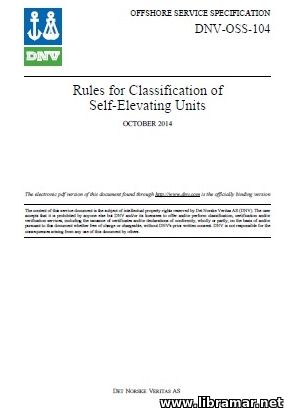 DNV-OSS-104 issued in 2014. Current changes; Introduction; General regulations and conditions - Classification principles, procedures, and conditions; Materials and welding - Metallic materials, structural fabrication; Hull and equipment - Structural design, watertight integrity and stability, towing; Machinery systems and equipment - Marine, machinery and piping systems, electrical installations, area arrangements, control and communication systems and emergency shutdown, fire protection, enhanced systems; Certification - Procedures, machinery and system certification; Newbuilding survey - Intro, survey planning, fabrication of structures, commissioning process, deliverables; Classification in operation - Intro, general provisions and requirements for surveys, preparation and planning, periodical surveys, other surveys, permanently installed self-elevating units; Historic changes.
The main and very important objective of the present DNV publication is to provide a concise yet complete overview of the technical standards relating to building and classing a conventional SEDU. Obviously, the information contained in the Rules will be of great use even when applied to the units classified by other societies.
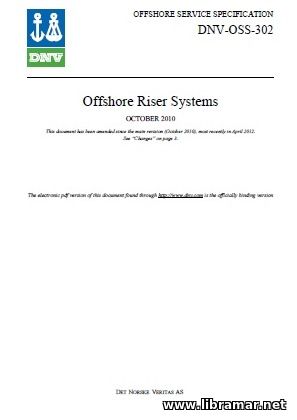 Offshore Service Specification no. DNV-OSS-302 is dedicated to the Offshore Riser Systems. It was released by Det Norske Veritas in October 2010 and remains the latest edition of the document. It was last amended in 2012 and all changes have been reflected on page 3 of the Specification. The document consists of three major parts - General, Technical Approach, and Service Overview.
As one of the leaders in the classification, DNV provides the offshore industry with services relating to the dynamic riser systems. In this definition, "dynamic" means non-stationary riser. Metallic and composite risers, umbilicals, flexible pipes and loading hoses are included in the "dynamic riser systems" notation. The main objectives of this OSS are to describe the overall competence and experience of DNV Class Society relating to such systems, and to describe the technical advisory, verification and certification services offered by DNV for dynamic riser systems.
This OSS is used by DNV as a reference when preparing proposals to the Clients, providing a clear understanding of the scope of work to be done. The document itself consists of three major sections supplemented with two appendixes...
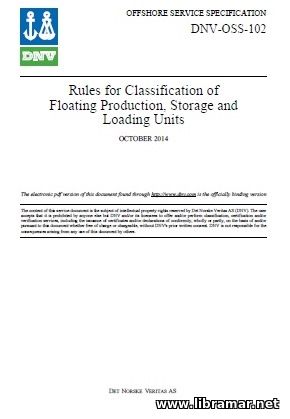 The publication presented to your attention presents the Rules developed and released by DNV classification society and addressing the FPS units and installations, stating the conditions and procedures used for the purpose of assigning and maintaining the classification status.
The publication consists of three parts providing general info on the basic principles of classification and procedures in use, the requirements relating to the design and construction for the phase of the newbuilding and, finally, requirements applicable to the maintenance of class status during the operation of the unit. The Rules apply to the offshore installations of the ship-shaped, column-stabilized, self-elevating, tension-leg and deep draught types utilized for the hydrocarbon production, loading, storage and offloading services.
There are some special considerations for conversions contained in the the first appendix, while the other two appendices provide the intro to the offshore classification and guidance on the mooring equipment acceptance standard. The opening and closing chapters of the publication provide information on the current and historical changes made to this document, correspondingly.
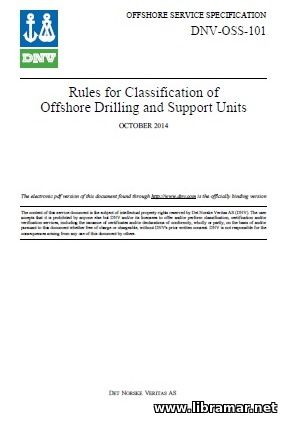 DNV-OSS-101 issued in 2014. Current changes; Principles and Procedures for Classification - Introduction, classification principles, classification scope and notations, assignment of class, retention of class, certification of materials, components and systems, legal provisions; Design and Construction Provisions - design and construction requirements for 1A1 MOU main class, supplementary requirements for drilling units, well intervention units, accommodation units, crane units, and wind turbine installation units, optional class notations; Classification in Operation - General provisions, general requirements for structure and machinery surveys, periodical survey extent for main class, miscellaneous main class surveys, periodical survey extent for additional service notations, optional class survey notations, alternative survey arrangements, surveys performed by approved companies; Introduction to Offshore Classification; Mooring Equipment Acceptance Standard Guidance; Historic changes - in short, this document contains all applicable requirements. It shall be on board any classed offshore installation and be used by both class inspector and crew members preparing their facility to the forthcoming inspection.
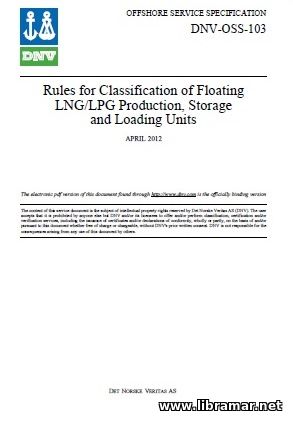 DNV-OSS-103 issued in 2012. Current changes; Principles/Procedures for Classification - intro, classification process, class maintenance, legal provisions etc.; Design and Construction Provisions - Main class - 1A1 MOU and OI floating offshore installation, supplementary requirements for service notations LNG (or LPG) Production Unit/Installation, LNG (LPG) Storage Unit/Installation, and LNG (LPG) Loading Unit/Installation optional class notations, additional class notations - requirements for special systems and equipment; Classification in Operation; Changes - Historic.
The publication states the general terms and applicable procedures for assigning and maintaining the class status of such facilities, including the list of technical references that are to be used in the process of classification. Though this paper refers primarily to LNG and LPG, the principles outlined herein may be used for any other offshore facility such as those involving CNG (i.e. compressed natural gas) and GTL (gas-to-liquid) products.
Note that this document applies to the floating steel structures and does not directly address concrete structures (please check DNV-OS-C503 for the requirements applicable to bottom-fixed and floating structures made of concrete).
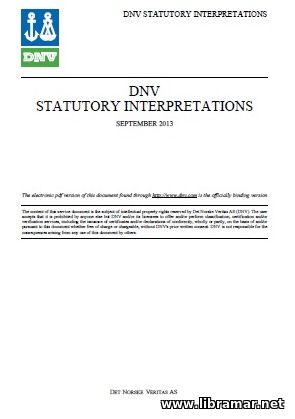 The DNV publication was issued in September 2013, it contains current and historic changes to statutory interpretations and supersedes DNV Statutory Interpretations dated February 2013. The SOLAS interpretations stated in this document cover construction, lifesaving arrangement, fire detection, protection and extinction, IMSBC and FSS Codes, GMDSS, ISM Code, safety of navigation, special measure to enhance maritime security, management for the safe operation of ships, acceptance and test criteria for water mist sprinkler system fitted in accommodation and service spaces.
The present publication is intended to present the DNV's interpretations of the various international statutory documents. Subject interpretations have been provided for the cases where there is no IACS UI or no any other interpretations. Note that this document covers only some selected relevant topics and must not be taken as the complete interpretations of DNV to international statutory instruments. In the cases where this Classification Society acts on behalf of the Flag, international statutory instruments, IACS UIs and our statutory interpretations shall be followed; any guidelines issued by IMO shall also be taken into account.
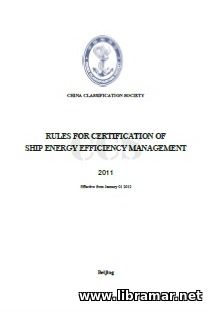 The present Rules were initially formulated by the professionals team of the CCS with the intention of establishing proper ship energy efficiency system and ship energy efficiency database, and to fully satisfy the applicable requirements of ship operators, charterers, ship and cargo owners, port authorities, flag administrations; other parties that may be involved in the above stated process, shall also be taken into account.
Below you may find the brief contents of this official publication: General Requirements and Responsibilities; Ship Energy Efficiency Management System and Data Requirements; Energy Efficiency Certification; Energy Efficiency Audit; Cross reference between Energy Efficiency Management System Requirements and ISM Code, ISO 14001-2004, and ISO 9001-2008; Ship Energy Efficiency Data Forms; Audit Requirements of the Modification of SEEMC/CEEMC; CEEMC, SEEMC and SEEVC Formats; Notification of Invalidation of EEMC.
These Rules may be used not only by the class surveyors, owners, managers, operators and crew members of the vessels that are classed by the CCS; they might also be used by people who wish to have some better idea of all requirements/responsibilities that are associated with the energy efficiency and its relation with the environment protection as it is outlined in the Marpol Convention - such requirements are there for any class.
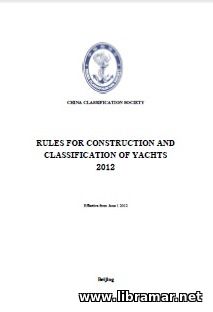 The CCS (standing for the Chinese Classification Society) Rules for Construction and Classification of Yachts published in 2012 consist of two big parts - the first part addresses yachts shorter than 24 m while the second one deals with larger yachts.
Each part has five principal chapters - general information, hull structure, machinery and electrical installations, and outfitting. In addition, in the last part some requirements for LPG power-driven yachts are listed. We would say that the publication contains literally all applicable Rules that are to be used during construction/commissioning of the yachts; of course, the Rules for surveys after constructions are also there in the Rulebook. The requirements for the compliance survey have been provided so that the inspectors are fully aware of the total scope of the inspections to be performed on board.
The information relating to the hull structure of the yacht includes three different materials. namely FRP, steel and aluminum. All yacht hull systems have also been addressed together with the shipboard machinery and electrical equipment and outfitting. Truly comprehensive reference book for new building and further maintenance of the yachts.
|







